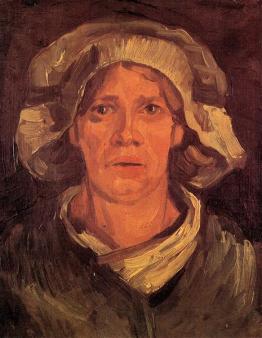
This portrait by Vincent van Gogh, Head of a Peasant Woman with a White Cap (Nuenen, 1885), is dramatic: for the lighting, the woman’s chiseled features, and the intense concentration and intelligence in her eyes. The image marks an equally dramatic turn in Vincent, Theo and the Fox, my children’s book story about van Gogh and growing up:
“On silent, padded paws the fox jumped to the kitchen counter, where there was a basket of potatoes. He took one and ate it….With a clang and a clatter, the potatoes spilled everywhere. One of the women looked over and saw the fox. She nudged her husband. “I shall catch that fox,” her husband said. “We shall eat him for supper. Later, I will make you a fur coat…”
I won’t reveal what happens next. Authors have to live, so please buy the book here to find out. However, I do want to talk about van Gogh’s portraits of peasant women. Here are four more examples of the many portraits of women created by van Gogh:




(These examples are from WikiArt.org- encyclopedia of visual arts, where you can find many more similar portraits.)
Van Gogh did not just paint peasant women, of course. Between 1881 and 1885 he made many paintings of women, men and couples. These paintings include both portraits and studies of working people engaged in everyday chores: sowing and sewing, fishing and weaving, farming and cooking.
Why did van Gogh make these and his other peasant character studies? First, he was aware of the industrialization creeping across the Netherlands. Vincent saw the changing landscape and its increasingly harsh impact on the working poor, who had little chance to change occupations. Second, as an artist, he admired another painter, Jean-François Millet, a pioneer of the “peasant genre” in the realism movement in art.
For a full explanation we also have to recognize that the life of peasants and the cycles of nature are closely related. The significance of that point becomes clear when we look at van Gogh’s own moral compass: he started out ministering to coal miners and trying to serve their needs. His life and work were dominated by intense spiritual needs even after he had renounced formalized religion. As Ann H. Murray, retired Assistant Professor of Art and Director of the Watson Gallery at Wheaton College, points out, Van Gogh painted landscapes and images of “simple people who lived in harmony with nature” because “he had turned to nature as his sole source of spiritual fulfillment and admittedly tried to express such feelings in his art.”
Back to the story. Why did I select the first portrait above to use in Vincent, Theo and the Fox? She’s looking to the right, first of all. In the story, the fox starts the scene by observing  the people in van Gogh’s famous painti
the people in van Gogh’s famous painti ng, The Potato Eaters, at their table. In my mind’s eye, van Gogh’s Basket of Potatoes was on a counter to the right.
ng, The Potato Eaters, at their table. In my mind’s eye, van Gogh’s Basket of Potatoes was on a counter to the right.
So the woman had to be looking in that direction. More importantly, the woman’s expression is neither contemplative nor beaten-down. She is focused on something see sees and she is reacting intently to it. Perfect for a story character seeing a fox trying to eat her poor family’s scarce potatoes.
It is stimulating and fun to weave stories around fine art. I believe anyone can do it if they try. The trick is to make sure that the choice in art (of which there are many) matches the arc of the story (where the possibilities are almost infinite but under your control). How do you think I did with this one match-up? Leave a comment, below. I’ll be sure to read it.
– Ted Macaluso
 For more reflections about van Gogh and religion, see my earlier essay, The Church at Auvers.
For more reflections about van Gogh and religion, see my earlier essay, The Church at Auvers.
If you are interested in learning more about van Gogh and nature, check out the Clark Art Institute’s Van Gogh and Nature, written by Richard Kendall, Sjraar van Heighten, and Chris Stolwijk [affiliate link].
If you liked this post and want to make sure you learn when future ones are posted, please subscribe to my newsletter by clicking here. Every other week you’ll receive news about blog posts on art, children’s books and writing; information about new books; and an occasional subscriber-only giveaway.
Ted Macaluso writes books for kids that make art more fun. His book, Vincent, Theo and the Fox, is a fictional adventure about the young Vincent van Gogh that teaches about growing up and learning from failure (for ages 4 – 10). He lives in Reston, Virginia with his wife, son, and kind hearted dog. Find out more at tedmacaluso.com.
© 2016 by Ted Macaluso. All rights reserved.


Thanks, Ted! I know little of art and am always happy to get another morsel of info. The only thing that brings me out of the flow of the narrative is the idea that a fox has invaded a house full of people and jumps up on a spot in clear view. My experience with foxes, including in my backyard, is that they are extremely skittish and I’ve only been close to them when they’ve been surprised or are defending young. Maybe if the fox got into the kitchen when everyone was asleep or out working in the fields? But maybe this isn’t a “real” fox?
LikeLike